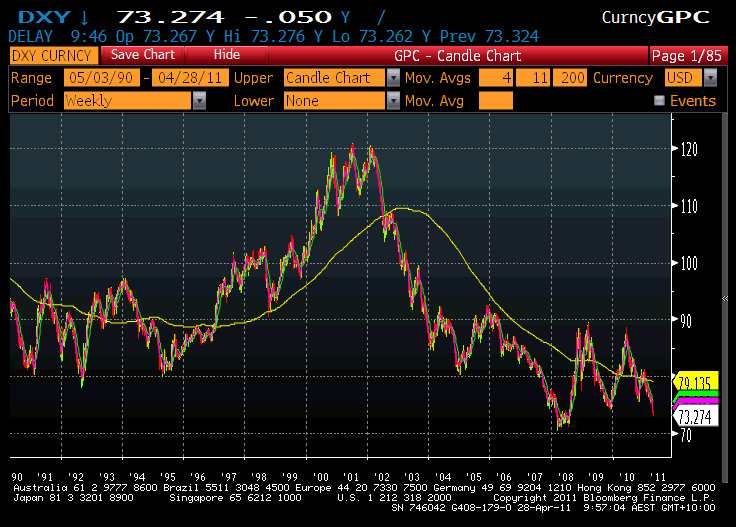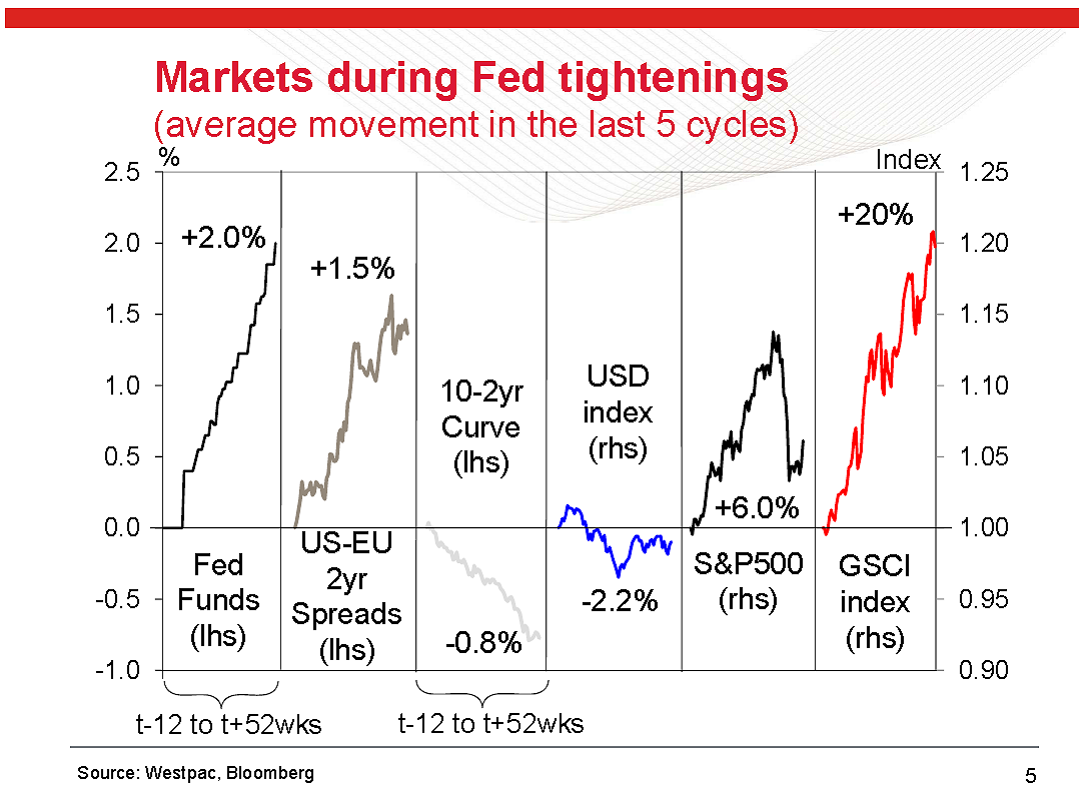As readers know the USD, as the other side of the AUD/USD coin, is one of my 5 key drivers of the Aussie as I have discussed before. So where it’s going and what it’s doing is a key to divining the future of the Australia dollar.
Since the mid-1990’s, starting with Robert Rubin, US Treasury Secretaries have from time to time felt the need to reiterate the so-called strong dollar policy. The current US Treasury Secretary, Tim Geithner, reiterated this in a discussion at the Council on Foreign Relations in New York on Tuesday night our time. Bloomberg quotes Geithner as saying:
Our policy has been and will always be, as long as at least I’m in this job, that a strong dollar is in our interest as a country,…We will never embrace a strategy of trying to weaken our currency to try to gain economic advantage.
But as the chart (from Bloomberg) below shows there is little recent evidence that this is the case:

Since August last year the USD has lost almost 19% against the AUD and CHF (Swiss Franc), 12% roughly against the EUR and Brazilian Real and even more starkly almost 5% against the GBP (British Pound), a currency backed by an economy that has had no growth for the past 6 months, 4% inflation and is waiting for austerity to really bite.
So you could be excused for thinking that Tim Geithner was being disingenuous with his comments above about his belief in a strong dollar. I’d argue the US Administration has not been bothered by the US Dollar’s weakness up to this point and while they may not be directly running a policy to weaken it, their mates at the Federal Reserve have effectively flooded the market with greenbacks, pushing the price down as supply has outmatched demand.
There are two questions worth trying to answer then. First, why has Geithner decided to roll out Bob Rubin’s old mantra and secondly what really is in store for the USD (and consequently the AUD) in the next 6 months or so.
Looking at the first question, the answer is that he was asked a direct question at the talk the other night and needed to give a fairly strong answer. The reason for this is that currency traders ears are very attuned to the comments of US Treasury Secretaries because they don’t cover this topic too often, unless they have to. Back in 2001 US Treasury Secretary Paul O’Neill when faced with a similar question and gave an honest answer saying:
We are not pursuing, as often said, a policy of a strong dollar. In my opinion, a strong dollar is the result of a strong economy.
No prizes for guessing what happened next, currency traders thought he was signalling that the US did not support a strong dollar and the US Treasury Department had to release a statement to say there had been no change policy and that the Secretary supported a strong dollar.
Indeed a couple of week’s later in 2001 O’Neill was forced to make the following statement.
I guess I made a mistake in thinking it was okay to talk beyond simplistic things. So I’ll make it very clear: I believe in a strong dollar, and if I decide to shift that stance I will hire out the Yankee Stadium and some rousing brass bands, and announce that change in policy to the whole world.
Now as the chart below shows O’Neill had the luxury of making these comments when the dollar was at or near the top of a 5 or 6 year uptrend and even then the USD got smashed. So when faced with a similar question Geithner has no choice given that the USD index is only 3 or 4% above the low of the last 20 years. To do otherwise than reinforce the “Strong Dollar Policy” risks a USD rout:

But the USD is in bad shape at the moment. The fact that it has lost ground to the GBP tells us that even if the price action in the above chart doesn’t shout it loud enough. So let’s look at the second question of what might be in store for thee USD in the next 6 to 12 months.
After Chairman Bernanke’s testimony overnight it is clear that QE is going to go till June but that it is likely to stop then. Bernanke said overnight it is the stock of what the Fed is holding not the flow of what the Fed is purchasing is the key to the accommodation in the economy. So even if they stop purchasing and there is no QE3 he sees monetary policy as loose.
I’ve made the case in the past that the Fed’s balance sheet growth has been inflationary for asset and commodity markets so I guess the corollary of this is that once they stop expanding, the USD will find support. But is this support likely to be weak, strong or absent?
Work by an old colleague of mine, Richard Franulovich who is Senior Currency Strategist at Westpac in New York suggests that any USD strength may be transitory. This is not good news for Aussie exporters or import competiting industries. Richard says that the USD will find a base but that:
It might not last long though – going back 25 years the USD has struggled in the early stages of tightening. Slide 4 shows the behaviour of key variables a year into the last 5 Fed hike cycles. On average, 1 year into tightening the Fed lifts cash by 2ppts, yield spreads move 150bp in the USD’s favour and the yield curve flattens 80bp. Yet, the USD tends to struggle. That might reflect the fact that commodities and equities rise in the first year of hikes too (see slide below). The Fed lags the Taylor path early in a hike cycle too implying that real interest rates remain low (i.e. it takes a certain amount of hikes before the USD can rally).
Indeed, when Richard looks at the performance of a number of markets on average over the last 5 US tightening cycles we see that the AUD’s current strength may actually out last even the most bullish buyers:
You’re probably asking how relevant the last 5 cycles are compared to this one, which is all about the end to the debt super cycle, and you could probably argue not overly. But if the GFC has taught us anything it is that the most dangerous words in the English Language are “this time its different”.
So the balance of probabilities are that the USD may find support soon around 3-4% lower than where it is now which translates in an AUD around 1.1175 to 1.1284. Please note this is not a forecast, and I am hearing that real money buyers are finally starting to say enough is enough, at least for the time being. However even though I am uncomfortable writing this next sentence (and I could be ringing the bell for the top) unless something changes fundamentally for the USD, the Aussie’s strength looks like it might persist stronger and for longer than many think.

